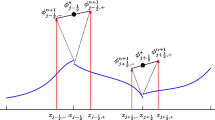Abstract
It is shown that the admissible solutions of the continuity and Bernoulli or Burgers' equations of a perfect one-dimensional liquid are conditioned by a relation established in 1949–1950 by Pauli, Morette, and Van Hove, apparently, overlooked so far, which, in our case, stipulates that the mass density is proportional to the second derivative of the velocity potential. Positivity of the density implies convexity of the potential, i.e., smooth solutions, no shock. Non-elementary and symmetric solutions of the above equations are given in analytical and numerical form. Analytically, these solutions are derived from the original Ansatz proposed in Ref. 1 and from the ensuing operations which show that they represent a particular case of the general implicit solutions of Burgers' equation. Numerically and with the help of an ad hoc computer program, these solutions are simulated for a variety of initial conditions called “compatible” if they satisfy the Morette–Van Hove formula and “anti-compatible” if the sign of the initial velocity field is reversed. In the latter case, singular behaviour is observed. Part of the theoretical development presented here is rephrased in the context of the Hopf–Lax formula whose domain of applicability for the solution of the Cauchy problem of the homogeneous Hamilton–Jacobi equation has recently been enlarged.
Similar content being viewed by others
REFERENCES
Ph. Choquard, “The homogeneous Hamilton–Jacobi and Bernoulli equations revisited, ” Found. Phys. 31, 623–640 (2001).
Ph. Choquard and F. Steiner, “The story of Van Vleck's and Morette–Van Hove's determinants, ” Helv. Phys. Acta 69, 636–664 (1996).
W. A. Woyczynski, Burgers-KPZ Turbulence: Göttingen Lectures (Lecture Notes in Mathematics, Vol. 1700) (Springer, 1998).
L. C. Evans, Partial Differential Equations (Graduate Studies in Mathematics, Vol. 19) (American Mathematical Society, 1998).
A. J. Chorin and J. E. Marsden, A Mathematical Introduction to Fluid Mechanics, 3rd edn. (Texts in Applied Mathematics, Vol. 4) (Springer, 1993).
Th. Strömberg, “The Hopf–Lax formula gives the unique viscosity solution, ” Differential and Integral Equations 15, 47–52 (2002).
J. Wagner, “Étude par analyse numérique des équations de continuité et d'Euler associées à différents modèles uni-dimensionnels de liquides conservatifs, ” Travail pratique de diplome, Section de Physique, 22 février 2002.
A. Quarteroni and A. Valli, Numerical Approximation of Partial Differential Equations (Series in Computational Mathematics, Vol. 23) (Springer, 1997).
E. D. Conway and E. Hopf, “Hamilton's theory and generalized solutions of the Hamilton– Jacobi equation, ” J. Math. Mech. 13, 939–986 (1964).
Ph. Choquard, “Toward a canonical-Hamiltonian and microscopic field theory of classical liquids, ” Physica A 279, 45–59 (2000).
Author information
Authors and Affiliations
Rights and permissions
About this article
Cite this article
Choquard, P., Wagner, J. The Homogeneous Hamilton–Jacobi and Bernoulli Equations Revisited, II. Foundations of Physics 32, 1225–1249 (2002). https://doi.org/10.1023/A:1019719219769
Issue Date:
DOI: https://doi.org/10.1023/A:1019719219769




